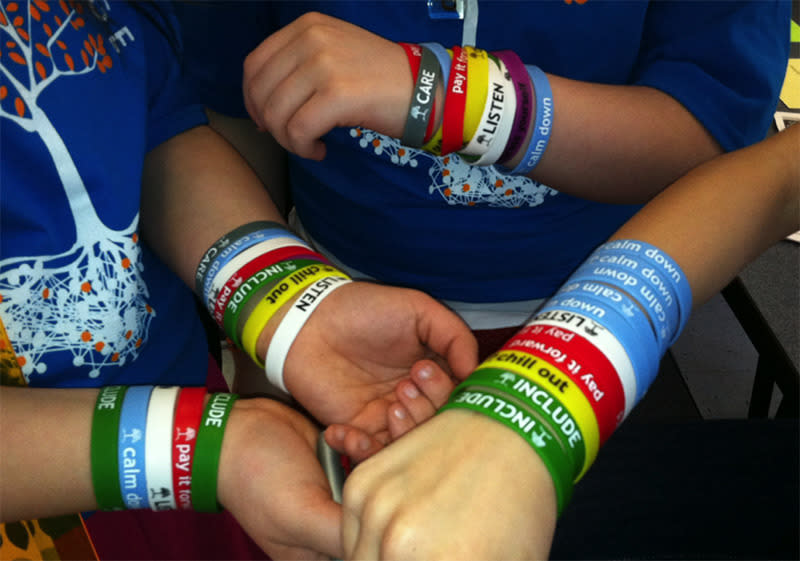Can 'Influential' Kids Stop Bullies?

Students with the most connections to other students, known as influencers or social referents, have a big effect on their schools’ social environments. A new study published in Proceedings of the National Academy of Sciences shows that when these students spread positive messages and highlight the dangers of bullying, real change can happen.
The research, conducted by a team hailing from Princeton, Rutgers, and Yale, started with the identification of influential students in 56 New Jersey middle schools. The team was most interested in the question of whether certain well-connected peers in a group had extra influence on social norms that could affect the behaviors of a larger school community. “We used social network mapping to identify the social referents based on what students told us about who they choose to spend time with,” lead author Elizabeth Levy Paluck, associate professor of psychology and public affairs at Princeton, tells Yahoo Parenting.
STORY: Teen Bullied Over Her Prom Dress Has the Last Laugh
Once they’d identified the influencers, researchers started asking questions about how to improve their schools, and students talked about wanting to feel more accepted, making school a less judgmental place. They then asked what social practices students would like to end, and what they could do more of to make everyone more comfortable at school. “Examples came up like ‘not calling students gay,’ or ‘inviting other people to sit with us at lunch,’” says Paluck.
They called the experiment the Roots program, and half of the middle schools were randomly assigned to implement it. The influential students at those schools were invited to Roots training sessions during school hours, and more than half attended regularly. It was in these sessions that student feedback was translated into action. Researchers trained students in dealing with conflict and gave them templates for various campaigns to be used on social media platforms like Instagram, in posters or on colorful wristbands, for example. The campaigns used the students’ own voices in messaging that discouraged bullying and encouraged positivity.
STORY: Should the Entire Class Attend Your Kid’s Birthday Party? The Great Debate
Some sample campaigns include one where influencers were each given 20 bright orange wristbands that read “A Roots student caught you doing something great” to hand out to peers who were helping other kids. There was also an #iRespect hashtag on Instagram to signify tolerance and conflict resolution — students hung brightly colored posters with the hashtag around the school and added their signatures to show they were involved. The theory was that these influencers sharing their anticonflict views publicly would effectively shape their peers’ behavior and outlook in the same direction.
After a year, the middle schools that hosted the Roots program saw a 30 percent reduction in student conflict reports. "Our program shows that you don’t need to use a blanket treatment to reduce bullying,” Paluck said. “You can target specific people in a savvy way in order to spread the message. These people — the social referents you should target — get noticed more by their peers. Their behavior serves as a signal to what is normal and desirable in the community. And there are many ways to figure out who those people are and work with them to inspire positive change.”
The schools that were not chosen to implement the Roots program were invited to receive free training on how to run the program at the end of the year. The first step is to identify influencers, and although the social network mapping used for the study would take a lot of time and resources, Paluck says that administrators and teachers can pinpoint social referents in an easier way. “Think about which students are well-connected,” she advises.
While “popular” students often come to mind first, there are also students who are well-connected in smaller circles — the theater crowd, band members, or even kids who like to hang out together in the back of the school. “These students are social referents for a narrower circle of students, but they shouldn’t be overlooked,” says Paluck. “Some of them aren’t as good at interacting with adults or aren’t seen as the ‘type’ of students who should participate in peer leadership campaigns, but they should absolutely be encouraged to participate, because they get a lot of attention from students in their social circles.”
Once influencers are onboard, Paluck says that the curriculum — which is available online — is easy to re-create. “The expenses are not great at all; most of the strategies used with students take very little materials or money,” she says, noting that the biggest expense is finding an adult who would be great at leading the group and facilitating student-led campaigns. “The beauty of our intervention is that it’s really adaptable to different schools. We don’t define the problems at the school, or the solutions — we just designed a set of group meetings to help students come up with the problems and solutions themselves.”
(Top Photo: Princeton University)
Please follow @YahooParenting on Facebook, Twitter, Instagram, and Pinterest. Have an interesting story to share about your family? Email us at YParenting (at) Yahoo.com.

